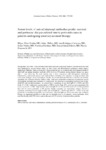Serum levels of anti-alphaGalactosyl antibodies predict survival and peritoneal dialysis-related enteric peritonitis rates in patients undergoing renal replacement therapy

Ver/
Use este enlace para citar
http://hdl.handle.net/2183/20738
A non ser que se indique outra cousa, a licenza do ítem descríbese como Atribución-NoComercial-CompartirIgual 4.0
Coleccións
- Investigación (FCS) [1293]
Metadatos
Mostrar o rexistro completo do ítemTítulo
Serum levels of anti-alphaGalactosyl antibodies predict survival and peritoneal dialysis-related enteric peritonitis rates in patients undergoing renal replacement therapyAutor(es)
Data
2006-11-06Cita bibliográfica
Pérez Fontán M, Máñez R, Rodríguez-Carmona A, Peteiro J, Martínez V, García-Falcón T, et al. Serum levels of anti-alphaGalactosyl antibodies predict survival and peritoneal dialysis-related enteric peritonitis rates in patients undergoing renal replacement therapy. Am J Kidney Dis. 2006;48(6):972-982
Resumo
[Abstract] Background: Anti-Galα1-3Gal antibodies (anti-αGal) represent a significant fraction of natural antibodies and were implicated in several disease states, yet their origin and physiological significance remain largely undisclosed. Methods: Under a prospective observational design, we estimated anti-αGal immunoglobulin G (IgG)/IgM and antipig hemolytic antibody (APA) levels in 133 patients starting dialysis therapy and again after a 1-year follow-up. We used baseline data to show correlations with demographic, nutritional, inflammatory, and anemia markers and analyzed their correlation with outcomes by using univariate and multivariate strategies of survival analysis. Results: Serum anti-αGal and APA levels showed wide baseline variability, but remained relatively stable in time. Both were measurable in dialysate of peritoneal dialysis (PD) patients, showing close correlation to serum levels. We observed no association between levels of anti-αGal/APA and nutritional markers, but showed direct correlations of anti-αGal IgM (P = 0.005) and APA levels (P = 0.001) with tumor necrosis factor α (TNF-α) levels. High APA levels also were associated with severe anemia (P = 0.006). High baseline anti-αGal IgM (P = 0.03) and APA levels (P = 0.045) predicted later risk for enteric peritonitis in PD patients. Finally, univariate and multivariate analyses showed a consistent association between high baseline anti-αGal IgM (P = 0.014) and APA (P = 0.021) levels and global risk for mortality during follow-up. Conclusion: Anti-αGal IgM and APA levels at the start of dialysis therapy are significant predictors of later risk for mortality and, in PD patients, enteric peritonitis. Both correlate directly with TNF-α levels and, in the case of APA, severity of anemia in these patients.
Palabras chave
Anti-αGalactosyl antibodies
Inflammation
Anemia
Peritoneal dialysis (PD)
Hemodialysis (HD)
Peritonitis
Inflammation
Anemia
Peritoneal dialysis (PD)
Hemodialysis (HD)
Peritonitis
Versión do editor
Dereitos
Atribución-NoComercial-CompartirIgual 4.0 © National Kidney Foundation, Inc.
ISSN
0272-6386
1523-6838
1523-6838






